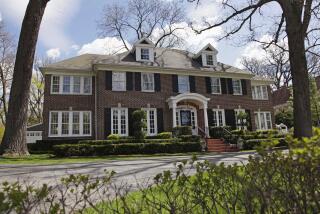There Was an Old Woman Who Lived in a Shoe ...
HELLAM, Pa. â Along a two-lane country road, the scenery offers up the architecturally impossible, or so it would seem -- a 25-foot-tall beige stucco replica of a manâs work boot worthy of Paul Bunyan.
Until recently, an elderly woman even owned the shoe. She didnât actually live there, although its three bedrooms, two bathrooms, kitchen and living room make it livable enough.
For eight years, Ruth Miller, 77, was tour guide for curious motorists who stopped by the Haines Shoe House on Shoe House Road, just east of York.
But Miller and her husband, Charles, 75, decided in June to put the house up for sale (asking price $129,000) because they wanted to travel and wouldnât be able to manage the house at the same time. They were the attractionâs only employees.
âThis morning, Iâm just sitting here contemplating. I really miss it already because I just loved that place. I still do,â Ruth Miller said just two days after closing the sale. âIf weâd have been younger, it would have never been for sale.â
The house, built in 1948, is considered âprogrammatic architecture,â buildings that resemble the products sold inside. Others, now regarded as kitschy roadside oddities of a bygone era, include the Coffee Pot luncheonette in Bedford; Big Duck in Flanders, N.Y., and Los Angelesâ Tail oâ the Pup hot-dog stand.
Most, built between 1910 and 1960, are related to the growing popularity of cars, said Bert Bedeau, president of the Society for Commercial Archeology, devoted to studying and preserving 20th century commercial signage and architecture.
âThe traditional way of attracting pedestrians was a sign.... That sign blends into the background when youâre going along at 35, 45, 55 miles per hour, so some retailers decided they needed to make their premises stand out,â Bedeau said.
The shoe house was conceived by Mahlon N. Haines, who moved to York County in his 20s and founded the Haines Shoe Co. At its height, the company had more than 40 stores in Pennsylvania and Maryland.
He hired an architect to base the design on one of his companyâs shoes as an advertising gimmick. Among other promotions, Haines invited honeymooners from any town with one of his stores to stay free for a weekend at the house, where they were provided with a cook, maid and chauffeur.
The layout is similar to that of a modern split-level home, with the honeymoon suite in the toe, the kitchen one floor above the heel, and servantsâ quarters and a bathroom on the top story.
Stained-glass windows throughout repeat the shoe motif, and the window in the front door incorporates an advertising photo of Haines with a shoe balanced on his fingertips.
Alex Drescher, 13, of neighboring Springettsbury Township, his older brother and younger sister were among a handful of visitors who took a tour on a recent afternoon.
âI think it would be fun to stay in it, but I wouldnât like to live here,â he said as the three of them ate ice cream dished up by Charles Miller in the basement, located in the heel.
Ruth Miller remembered seeing the house under construction, a sight that led neighbors to conclude that Haines -- who also preached the virtues of good health with such fervor that he offered cash to smokers on the street if they promised to quit -- âmust have gone senile.â
When Haines died in 1962 at age 87, he left the house to his employees, who sold it to a dentist two years later. It operated for about 20 years as an ice cream parlor, and building tours were available. Hainesâ granddaughter, Annie, bought it in 1987 and renovated it, but the bank repossessed it because she was unable to keep maintaining it, Ruth Miller said. Annie Haines did not return a telephone call seeking comment.
The foreclosure sale in the local newspaper caught Ruth Millerâs attention, and a rumor that some prospective buyers wanted to move it out of state fueled her interest even more.
âThis is where it belongs,â she said. âIf you move it out of here, the meaning would be all gone.â
New owner Carleen Farabaugh has assured Miller that the shoe will stay firmly planted in Pennsylvania. Farabaugh, who did not reveal the purchase price, plans to maintain the tours and hopes to expand the operating hours next summer.
âI really fell in love with it the minute I saw it,â she said. âThe historical side is fantastic. Itâs something we need to pass on to our children.â
More to Read
Sign up for The Wild
Weâll help you find the best places to hike, bike and run, as well as the perfect silent spots for meditation and yoga.
You may occasionally receive promotional content from the Los Angeles Times.






